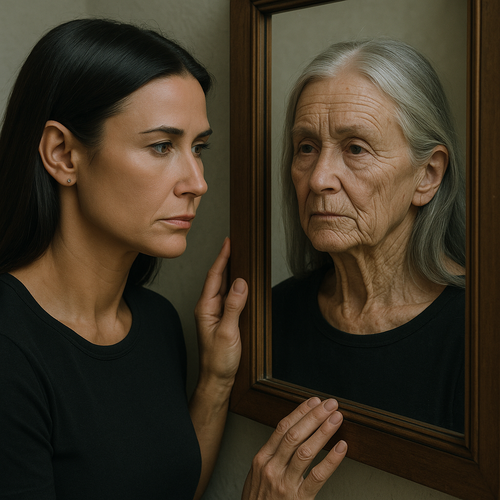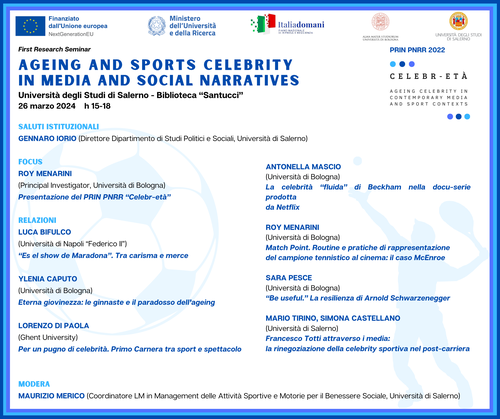EVENTS

THE OLDER, THE BETTER! AGEING CELEBRITY IN CONTEMPORARY MEDIA AND SPORT CONTEXTS
PRIN 2022 PNRR “CELEBR-AGE” FINAL CONFERENCE organised by Ylenia Caputo, Simona Castellano, Antonella Mascio, Roy Menarini, Maurizio Merico, Sara Pesce, Mario Tirino
WHEN: 15 - 17 September, 2025
WHERE: Bologna, Teatro DAMSLab Piazzetta Pasolini 5/b; Aule 1, 2 and 3, Via Azzo Gardino 33; Aula Poeti, Palazzo Hercolani, Strada Maggiore 45
KEYNOTE SPEAKERS
HENRY JENKINS (Provost Professor, University of Southern California)
Title
"Just a Spoonful of Sugar": Dick Van Dyke, Mary Poppins, and Playful Aging
Abstract
In the 1950s and 1960s, Permissiveness, as advocated by Benjamin Spock, Margaret Mead, and others in their circles, became the dominant way of thinking about American family life. It is often understood as an approach for thinking about children and their lives (and it was that!) but it also was a way of thinking about adulthood, how adults relate to children but also how they might live better lives. For exaple, fathers playing with their children were not only building a more solid foundation for their offspring's future luves but also revitalizing their own lives, creating a self identity outside their jobs. My recent book, Where the Wild Things Were: Boyhood and Permissive Parenting in Postwar America, begins with an analysis of Mary Poppins as a fil which modeled the transition from autocratic to permissive parenting. I want to revisit it as a film which also offers a range of models for adulthood — from the laughing uncle, the iaginative Bert, the playful chumney sweeps, the work obsessed bankers, and finally, the kite-flying Mr. Banks once he has been "saved" by the film's protagonists. Then, I want to explore how Dick Van Dyke, so central to Mary Poppins, has continued to explore what a playful and permissive aging ight look like as he approaches his one hundredth birthday. He still sings, he still dances, he still clowns, and he publically states that these things help him to stay youbg, even if he also acknowledges loneliness over the loss of old friends. As someone who was one of the boys in the striped shirts who came of age in the permissive era and who is now becoming a senior citizen, I find myself once again taking inspiration in Dick Van Dyke's example.
*
RENIRA RAMPAZZO GAMBARATO (Professor in Media and Communication Studies, Jönköping University, Sweden)
Title
Unpacking Ageism in Streaming Media: Cultural Memory and The White Lotus
Abstract
Streaming media has transformed the entertainment industry, offering both opportunities and challenges for aging celebrities. While streaming platforms enable sustained visibility for older actors, opportunities for career resurgence, and nostalgic repackaging of aging stars for new and old audiences, they often reinforce ageist narratives, limiting roles to stereotypes of decline, wisdom, or irrelevance. Some series challenge these norms, integrating older characters in nuanced ways. Recent shows such as Hacks (Max), A Man on the Inside (Netflix), Only Murders in the Building (Disney+), and Shrinking (Apple TV) explore themes of aging, revealing both progressive and regressive portrayals.
Among these, the highly acclaimed HBO Max series The White Lotus serves as a compelling case study to explore how ageing celebrities are implicated in cultural memory. Astrid Erll’s framework of intra-medial, inter-medial, and pluri-medial dimensions provides a useful lens for analyzing The White Lotus in relation to cultural memory. Aging celebrities such as Jennifer Coolidge (Tanya McQuoid, season 1 and 2) and Parker Posey (Victoria Ratliff, season 3) serve as nostalgic figures, reinforcing past media memories from the 1990s while reshaping their relevance in contemporary television and social media. Social media discourse surrounding The White Lotus revives and reshapes the careers of these actors, giving them renewed cultural capital. Memes, interviews, and awards discourse reinforce a collective cultural memory around these celebrities, transforming their image from “forgotten” to “iconic.” The White Lotus functions as a cultural memory machine—revitalizing forgotten figures, commenting on generational anxieties, and engaging in intertextual dialogue with media history.
*
MATT HILLS (Honorary Professor, University of Bristol)
Title
An Ageing Celebrity “Time Lord”: The Timescapes of Foreverism and Nostalgic Fandom
Abstract
Contra approaches based on nostalgia (e.g. Lizardi 2015), this talk will consider the value of applying hauntology (Fisher 2012 and 2014) to ageing celebrity. Cultural critic Mark Fisher has defined hauntology as involving both a “no longer” and a “not yet”, and this doubled timescape — referring backwards and forwards — will provide a way of theorising ageing celebrity in relation to its split between established media images and the celebrity’s biographical, embodied self.
Following work on David Bowie as a hauntological celebrity (Perrot 2019), I will focus on Tom Baker as my case study: Baker took on the role of the Fourth Doctor in BBC TV’s Doctor Who in the mid-1970s at the age of 39, and continues to participate in fan events today, aged 91. With a celebrity image based on excess and storytelling, Baker reflexively gives voice to ‘Tom Baker’ while lamenting the disjuncture between his current ageing and his younger mediated self, and projecting imaginatively forward into posthumous celebrity and the “foreverist” (Tanner 2023) franchised continuation of his most famous role, the time-travelling alien Doctor Who.
*******
CALL FOR PAPERS
Celebrities occupy a prominent position in contemporary (media) society for several reasons. In addition to being a form of ‘commodity’ used by the media industry (Turner, 2004), they represent devices capable of creating connections between the media world and the audience world, acting as models for inspiration.
For an ever-increasing number of subjects (people, users, audiences), the activities, speeches and performances of celebrities become symbolic materials, forms of cultural mediation through which they elaborate their own interpretations of the world. In the words of Nick Couldry (2009), it seems useful to look at celebrity as ‘a generative centre that explains the social world's functioning and its values’, i.e. a privileged access point for interpreting a set of fundamental phenomena affecting society.
Many studies have been carried out on celebrities, starting with the figures who embody this role and the type of relationship they have with their publics, also highlighting their ‘measure’ (macro, meso and micro measure, Marwick, 2007). However, few analyses have accompanied these reflections regarding ‘elderly’ celebrities, i.e. all those celebrities who have reached a certain age threshold. Their role seems to have changed compared to the past and the media spaces in which they appear are increasingly numerous and differentiated (films, TV series, social networks...) bringing significant novelties not only on a spectacular level, but also - and perhaps most importantly - on a cultural and social ones.
Ageing is increasingly evident in the world's population, with a significant impact on the economy, politics and social life of many countries. As a result, the cultural models referred to over the past three decades have changed rapidly: advertising, cinema, sports and other spheres now propagate conceptions of ageing under the banner of intellectual activism, psycho-physical well-being and social prominence.
Within a vast constellation of phenomena, events and products that, in various ways, shape new and often contradictory conceptions of ageing, the cultural discourses elaborated by celebrities assume a clear centrality in the mediatised public scene.
For this reason, it now appears necessary to analyse in depth the link between celebrity and ageing, from a multidisciplinary and transcultural perspective.
Download Here the Conference Program

Ageing and Sports Celebrity in Media and Social Narratives
First Research Seminar "Ageing and Sports Celebrity in Media and Social Narratives", nell'ambito del PRIN PNRR 2022 “Celebr-età. Ageing celebrity in contemporary media and sport contexts: a model of social cultural well-being”, sviluppato dalle Unità di Ricerca di Bologna (capofila) e Salerno.
WHEN: 26 MARCH 2024, from 3.pm to 6 p.m
WHERE: Biblioteca A. Santucci, Università degli Studi di Salerno, Via Giovanni Paolo XXIII, 132, 84084 Fisciano SA